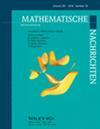求助PDF
{"title":"宇宙无毛猜想与共形矢量场","authors":"Seungsu Hwang, Gabjin Yun","doi":"10.1002/mana.70025","DOIUrl":null,"url":null,"abstract":"<p>In this paper, we investigate cosmic no-hair properties mathematically when a given Riemannian manifold admits a nontrivial closed conformal vector field. Let <span></span><math>\n <semantics>\n <mrow>\n <mo>(</mo>\n <msup>\n <mi>M</mi>\n <mi>n</mi>\n </msup>\n <mo>,</mo>\n <mi>g</mi>\n <mo>)</mo>\n </mrow>\n <annotation>$(M^n, g)$</annotation>\n </semantics></math> be a compact Riemannian <span></span><math>\n <semantics>\n <mi>n</mi>\n <annotation>$n$</annotation>\n </semantics></math>-manifold with connected non-empty boundary <span></span><math>\n <semantics>\n <mrow>\n <mi>∂</mi>\n <mi>M</mi>\n </mrow>\n <annotation>$\\partial M$</annotation>\n </semantics></math>. Assume that there exists a smooth function <span></span><math>\n <semantics>\n <mi>f</mi>\n <annotation>$f$</annotation>\n </semantics></math> on <span></span><math>\n <semantics>\n <mi>M</mi>\n <annotation>$M$</annotation>\n </semantics></math> with <span></span><math>\n <semantics>\n <mrow>\n <mi>f</mi>\n <mo>></mo>\n <mn>0</mn>\n </mrow>\n <annotation>$f>0$</annotation>\n </semantics></math> in <span></span><math>\n <semantics>\n <mrow>\n <mi>M</mi>\n <mo>∖</mo>\n <mi>∂</mi>\n <mi>M</mi>\n </mrow>\n <annotation>$M \\setminus \\partial M$</annotation>\n </semantics></math> and <span></span><math>\n <semantics>\n <mrow>\n <mi>∂</mi>\n <mi>M</mi>\n <mo>=</mo>\n <msup>\n <mi>f</mi>\n <mrow>\n <mo>−</mo>\n <mn>1</mn>\n </mrow>\n </msup>\n <mrow>\n <mo>(</mo>\n <mn>0</mn>\n <mo>)</mo>\n </mrow>\n </mrow>\n <annotation>$\\partial M = f^{-1}(0)$</annotation>\n </semantics></math> satisfying the static vacuum equation. We prove that if <span></span><math>\n <semantics>\n <mrow>\n <mo>(</mo>\n <msup>\n <mi>M</mi>\n <mi>n</mi>\n </msup>\n <mo>,</mo>\n <mi>g</mi>\n <mo>)</mo>\n </mrow>\n <annotation>$(M^n, g)$</annotation>\n </semantics></math> admits a nontrivial closed conformal vector field, then <span></span><math>\n <semantics>\n <mi>M</mi>\n <annotation>$M$</annotation>\n </semantics></math> must be isometric to a hemisphere <span></span><math>\n <semantics>\n <msubsup>\n <mi>S</mi>\n <mo>+</mo>\n <mi>n</mi>\n </msubsup>\n <annotation>${\\mathbb {S}}_+^n$</annotation>\n </semantics></math>. We also discuss a static triple <span></span><math>\n <semantics>\n <mrow>\n <mo>(</mo>\n <msup>\n <mi>M</mi>\n <mi>n</mi>\n </msup>\n <mo>,</mo>\n <mi>g</mi>\n <mo>,</mo>\n <mi>f</mi>\n <mo>)</mo>\n </mrow>\n <annotation>$(M^n, g, f)$</annotation>\n </semantics></math> admitting a nontrivial conformal vector field which is not necessarily closed.</p>","PeriodicalId":49853,"journal":{"name":"Mathematische Nachrichten","volume":"298 9","pages":"3061-3074"},"PeriodicalIF":0.8000,"publicationDate":"2025-07-31","publicationTypes":"Journal Article","fieldsOfStudy":null,"isOpenAccess":false,"openAccessPdf":"","citationCount":"0","resultStr":"{\"title\":\"Cosmic no-hair conjecture and conformal vector fields\",\"authors\":\"Seungsu Hwang, Gabjin Yun\",\"doi\":\"10.1002/mana.70025\",\"DOIUrl\":null,\"url\":null,\"abstract\":\"<p>In this paper, we investigate cosmic no-hair properties mathematically when a given Riemannian manifold admits a nontrivial closed conformal vector field. Let <span></span><math>\\n <semantics>\\n <mrow>\\n <mo>(</mo>\\n <msup>\\n <mi>M</mi>\\n <mi>n</mi>\\n </msup>\\n <mo>,</mo>\\n <mi>g</mi>\\n <mo>)</mo>\\n </mrow>\\n <annotation>$(M^n, g)$</annotation>\\n </semantics></math> be a compact Riemannian <span></span><math>\\n <semantics>\\n <mi>n</mi>\\n <annotation>$n$</annotation>\\n </semantics></math>-manifold with connected non-empty boundary <span></span><math>\\n <semantics>\\n <mrow>\\n <mi>∂</mi>\\n <mi>M</mi>\\n </mrow>\\n <annotation>$\\\\partial M$</annotation>\\n </semantics></math>. Assume that there exists a smooth function <span></span><math>\\n <semantics>\\n <mi>f</mi>\\n <annotation>$f$</annotation>\\n </semantics></math> on <span></span><math>\\n <semantics>\\n <mi>M</mi>\\n <annotation>$M$</annotation>\\n </semantics></math> with <span></span><math>\\n <semantics>\\n <mrow>\\n <mi>f</mi>\\n <mo>></mo>\\n <mn>0</mn>\\n </mrow>\\n <annotation>$f>0$</annotation>\\n </semantics></math> in <span></span><math>\\n <semantics>\\n <mrow>\\n <mi>M</mi>\\n <mo>∖</mo>\\n <mi>∂</mi>\\n <mi>M</mi>\\n </mrow>\\n <annotation>$M \\\\setminus \\\\partial M$</annotation>\\n </semantics></math> and <span></span><math>\\n <semantics>\\n <mrow>\\n <mi>∂</mi>\\n <mi>M</mi>\\n <mo>=</mo>\\n <msup>\\n <mi>f</mi>\\n <mrow>\\n <mo>−</mo>\\n <mn>1</mn>\\n </mrow>\\n </msup>\\n <mrow>\\n <mo>(</mo>\\n <mn>0</mn>\\n <mo>)</mo>\\n </mrow>\\n </mrow>\\n <annotation>$\\\\partial M = f^{-1}(0)$</annotation>\\n </semantics></math> satisfying the static vacuum equation. We prove that if <span></span><math>\\n <semantics>\\n <mrow>\\n <mo>(</mo>\\n <msup>\\n <mi>M</mi>\\n <mi>n</mi>\\n </msup>\\n <mo>,</mo>\\n <mi>g</mi>\\n <mo>)</mo>\\n </mrow>\\n <annotation>$(M^n, g)$</annotation>\\n </semantics></math> admits a nontrivial closed conformal vector field, then <span></span><math>\\n <semantics>\\n <mi>M</mi>\\n <annotation>$M$</annotation>\\n </semantics></math> must be isometric to a hemisphere <span></span><math>\\n <semantics>\\n <msubsup>\\n <mi>S</mi>\\n <mo>+</mo>\\n <mi>n</mi>\\n </msubsup>\\n <annotation>${\\\\mathbb {S}}_+^n$</annotation>\\n </semantics></math>. We also discuss a static triple <span></span><math>\\n <semantics>\\n <mrow>\\n <mo>(</mo>\\n <msup>\\n <mi>M</mi>\\n <mi>n</mi>\\n </msup>\\n <mo>,</mo>\\n <mi>g</mi>\\n <mo>,</mo>\\n <mi>f</mi>\\n <mo>)</mo>\\n </mrow>\\n <annotation>$(M^n, g, f)$</annotation>\\n </semantics></math> admitting a nontrivial conformal vector field which is not necessarily closed.</p>\",\"PeriodicalId\":49853,\"journal\":{\"name\":\"Mathematische Nachrichten\",\"volume\":\"298 9\",\"pages\":\"3061-3074\"},\"PeriodicalIF\":0.8000,\"publicationDate\":\"2025-07-31\",\"publicationTypes\":\"Journal Article\",\"fieldsOfStudy\":null,\"isOpenAccess\":false,\"openAccessPdf\":\"\",\"citationCount\":\"0\",\"resultStr\":null,\"platform\":\"Semanticscholar\",\"paperid\":null,\"PeriodicalName\":\"Mathematische Nachrichten\",\"FirstCategoryId\":\"100\",\"ListUrlMain\":\"https://onlinelibrary.wiley.com/doi/10.1002/mana.70025\",\"RegionNum\":3,\"RegionCategory\":\"数学\",\"ArticlePicture\":[],\"TitleCN\":null,\"AbstractTextCN\":null,\"PMCID\":null,\"EPubDate\":\"\",\"PubModel\":\"\",\"JCR\":\"Q2\",\"JCRName\":\"MATHEMATICS\",\"Score\":null,\"Total\":0}","platform":"Semanticscholar","paperid":null,"PeriodicalName":"Mathematische Nachrichten","FirstCategoryId":"100","ListUrlMain":"https://onlinelibrary.wiley.com/doi/10.1002/mana.70025","RegionNum":3,"RegionCategory":"数学","ArticlePicture":[],"TitleCN":null,"AbstractTextCN":null,"PMCID":null,"EPubDate":"","PubModel":"","JCR":"Q2","JCRName":"MATHEMATICS","Score":null,"Total":0}
引用次数: 0
引用
批量引用
摘要
本文从数学上研究了给定黎曼流形存在非平凡闭共形向量场时的宇宙无毛性质。设(mn, g)$ (M^n, g)$是一个紧黎曼n$ -流形,它具有连通的非空边界∂M$ \偏M$。假设在M$ M$上存在一个平滑函数f$ f$, f>0$ f>0$在M∈∂M$ M \setminus \partial M$中,并且∂M = f−1 (0)$ \partial M = f^{-1}(0)$满足静态真空方程。我们证明了如果(mn, g)$ (M^n, g)$存在一个非平凡闭共形向量场,那么M$ M$一定是等距于半球S + n$ {\mathbb {S}}_+^n$。我们还讨论了一个静态三元组(mn, g, f)$ (M^n, g, f)$,它允许一个不一定闭合的非平凡共形向量场。
本文章由计算机程序翻译,如有差异,请以英文原文为准。

 求助内容:
求助内容: 应助结果提醒方式:
应助结果提醒方式:


